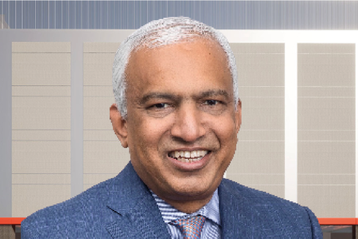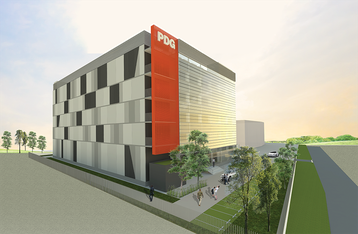Rangu Salgame comes from India, and has built at least three big businesses there - but he sees himself as a citizen of the world, most at home in New York and Singapore.
He caught the technology wave early at M S Baroda University, Gujarat. He got funding for a solar project while still a student - and then lit out for the US where he spent the first two decades of the Internet in New York building a technology career, rising to become a Verizon president.
“I’m originally from India, but that has no bearing on my business life,” he says. “I'm from New York and that is the center of my business life.”
In the dot-com boom, he had a startup. A content delivery platform called Edgix, its name and premise sound oddly prescient, like one of today’s would-be unicorns.
This feature appeared in Issue 44 of the DCD Magazine. Subscribe for free today
But in the early 2000s, like a lot of other dot-com babies, it died.
Growing Cisco, building Tata
In 2003, Salgame became Cisco’s leader in India, building the network giant’s Indian business to $1 billion in the five years he worked there. However, he points out that he ran that business from New York.
After Cisco, he was involved in the Indian network startup Tejas Networks for a brief time, leaving after only four months. A few years at network security firm Niksun followed, after which he joined the Indian telco Tata Communications in 2012, running a set of businesses as CEO of growth ventures and the service provider group.
While at Tata, he had an impact on data centers, and India, but he downplays both: “I was based in New York, not India,” he reiterated. “I ran a portfolio business in Tata Communications. I ran a wholesale business, a carrier business, and a media business.”
At that stage, he says: “One of my businesses was data center, which included the India business, but we had data centers in Europe and the US - in San Jose, New York City, and LA, as well Slough in the UK.”
At this stage, a lot of telcos were quickly building up data center arms, seeing the sector as a growth opportunity. Tata’s growth in India was striking, expanding quickly to a total of 44 data centers, giving it a quarter of India’s data center market.
This wasn’t just a colocation business, but under Salgame’s guidance, it became a separate business, dealing with hyperscale customers: “I took the Asia part of the data center business - India and Singapore - and I put that into a separate subsidiary [in 2014]. Then we invested capital to transform that to a hyperscale business.”
Tata was early in focusing on hyperscale, he said: “Particularly, at that time, in India at the time and Singapore.”
That business was all “about anticipating where the hyperscale market is going, anticipating the demand and making speculative bets from a capital perspective - so you can build something that you believe that the customers are gonna come to. I think that's what we did in Tata.”
The telco sell-off
Then abruptly, in 2016, Tata sold its data center business: “I was part of that journey,” he told us. “Now the world is doing hyperscale, but six years ago Tata decided to exit.”
It was a global phenomenon, as telcos around the world thought better of their data center involvement: “Telecoms companies couldn't afford to be a data center business. The scale of capital and the economics were very different than the network economics. It was a trend that started and it is just going to continue, where the industry is quite bifurcated now.”
He explains: “Public shareholders look at the telecom business very differently than the data center business - where it takes half a billion dollars to build one project. In data centers, the economics are very long term, and you get better returns as a data center company - but in a different way.”
Tata was one of the first telcos to see the writing on the wall: “We were one of the first telecoms companies to get out of the data center business, and then many others followed, “ he says, mentioning Verizon, AT&T, and CenturyLink, as well as Telefonica in Europe.
Tata’s sold its majority stake in the data center business to STT: “We saw it as very logical to let the business grow with a different kind of capital. We sold the majority stake to STT – and after the transaction, I left to form PDG.”
Birth of Princeton
Princeton Digital Group would emerge in 2018, based in Singapore, with backing from Warburg Pincus, and a goal to build “a multi-billion data center portfolio” across Asia. Salgame’s co-founder is Varoon Raghavan, who worked with him at Tata: “He was my key guy on data centers. He and I were very closely involved in building the hyperscale business, and then in doing the M&A transaction to sell it.”
PDG had a good chance, because “the hyperscale business for data centers in Asia is becoming a sector in itself,” he says. “It has a large-scale capital requirement, and you need design engineering capabilities, that can be replicated across different markets. I think that's a core to how the industry is going.”
The company began acquiring capacity, starting with five facilities from Indonesian telco XL Axiata in 2019. This, like Tata’s sale, was another fallout from the telcos’ big data center divestment, he explains.
PDG also bought IO’s facility in Singapore – which became available after Iron Mountain bought the provider’s US facilities.
But as well as buying, PDG was building from the start, and making informed guesses where the hyperscalers would want to be. Its first $500 million phase included land in the Chinese industrial cities of Nanjing, Nantong, and Wuxi, along with a 40MW data center campus in Shanghai.
“We have a multi-country data center play, to engage with the hyperscalers, strategically across different markets,” he tells us. “And that has played out very well for us.”
New investors have come on board, including the Ontario Teachers’ Pension Plan Board, and China Merchants Bank. And during 2020 and 2021, PDG began projects in India and Japan, taking it to five nations, with a 600MW portfolio of 20 data center projects - 10 in operation and ten in various stages of development.
Indian campuses
“India is a long-term play, with an aggressive starting point,” says Salgame. “It’s a 48MW campus in Navi Mumbai, just outside the city.”
The building is a data center cluster, with the same building design PDG uses in other markets: “That gives us entry into the market at scale.”
Looking forward three to five years, he is ambitious, predicting that PDG’s India operation itself could be bigger than the 600MW size of the whole company’s portfolio today: “I won't be surprised if PDG has that scale across three to four cities in India,” he says, calling out Chennai and Delhi as potential targets.
Another Tata alumnus, Vipin Shirsat, is head of India for PDG.
Recently India classified data centers as critical infrastructure. “That is already helping,” says Salgame. “Long term, it's going to be a tremendous boost to the industry. When the nation classifies this as strategic infrastructure, then there is a lot of impetus for financial institutions. The cost of capital for the industry go down, which is going to spark a lot of investment in India.”
Among other things, mobile operators now have the confidence to invest in 5G networks, he says, “and that is going to spawn more apps and services.” In the last year, he reckons “30 or 40 unicorns have popped up in India, on the tech side of the market.”
Abu Dhabi money
When we speak, PDG had just received another $500 million, led by the Abu Dhabi government's investment arm, Mubadala, and Salgame is looking back on significant growth in 2021.
“In 2021 we entered new markets like Japan, we announced a project in Mumbai, and we started a new project in Jakarta,” he tells us. “We are expanding further in China. So we were coming out of the year in a much stronger position than we entered the year.”
Now he says that PDG has “proven its thesis,” and is consolidating its position as “the de facto leading operator in the Asia Pacific region.”
That gives it the clout to get Arab money from Mubadala, with no strings attached: “This is a straight out equity investment at the highest level of the company. The money's in the bank.”
To reach that spot, PDG has been “very disciplined in our investment approach,” and chose its markets carefully, picking nations that were investing heavily in digitization and were open to developers.
“The economies we serve are investing more in digitalization,” he says, and with demands growing “even faster than anticipated,” PDG is accelerating its already-impressive growth plans.
Multi-country strategy
But being the leading multi-country developer in Asia does have its positives and negatives. On the one hand, it isn’t a global player. Is that limiting? “No, we had a strong conviction from day one, that we are only in Asia. We are not taking our eyes off Asia. So no other geographies.”
On the other hand, maybe it loses through not focusing on a single country?
“No, I think we are not spread too thin across Asia. We are in key markets that matter to our customers. A little over four years ago, when we started the business, we had a very strong view that a time was just about to come when hyperscalers’ investment in Asia was going to go up dramatically. And when that happens, they would want their partners, suppliers, and operators to be strategic, and multi-country because doing business in Asia is not easy.”
The multi-country model enables PDG to iron out the differences between countries for its giant customers: “They are a business which is growing fast across multiple countries, and they need partners who can help them grow across multiple countries at the same time,” he says.
“The thesis of being a provider across multiple countries is that our customers want the company's liquidity to be across multiple countries. They want to have the same quality of service, the same SLAs across markets. They want to set the same set of expectations to an operator, so that no matter what geography, what city they go to they can call up PDG and work with PDG.”
He says PDG’s relationship with its customers is “symbiotic.” PDG gets insights into what hyperscalers want and delivers that.
Choosing target countries
“I think the multicountry strategy is really playing out fortunately for us. Asia has so many countries, we can't afford to be in every one of them, so we have chosen our markets carefully from two perspectives. First, what matters to our customer. And second, the long term size of the market has to be reasonable to deploy capital and get good financial returns,” he said.
There are some smaller Asian countries, he says, “that we will not have the energy to pay attention to in the coming years. The countries we are in - Singapore, China, Indonesia, India, and Japan - are the five countries that we are able to execute.
“We may enter a couple of more countries, maybe two or at a maximum three,” he says. He won’t be specific about which ones, but agrees that Korea is a large market - though “it's a very difficult country to enter for data center customers”
Australia is also an important market, where an operator with no ties to China can get government business, and PDG is “backed by capital from North America and sovereign funds from Abu Dhabi.”
But don’t look for any sudden moves: “We are very disciplined. We look for the right opportunity to get in. We also have very patient capital management, so we don't rush for the sake of rushing.”
After the Singapore moratorium
Singapore is a potentially awkward choice, given the country has had a moratorium, which is opening up, but is likely to restrict the size of new data center projects.
Salgame says he will build in Singapore, if PDG gets the chance, but has a strong base in its acquired IO data center: “Singapore will continue to be an important market. We are headquartered here and I think our customers want us to be doing more in Singapore. We don't know how the new policies will play out, so we will watch it and see.”
He’s still keen, even if size is limited: “Singapore is not going to be the campus scale that we have in Tokyo, Mumbai, or China. We understand that, but I think it's about it's going to be a digital hub.
“I think we are going to watch for the policy to really get laid out. And we’ve been told, in the next month or so, it will be, it will be clearer in terms of the process and some of the criteria details.”
Renewable energy
Salgame says renewable energy is “front and center,” but it has to be done “market by market, because national grids and policies vary so much.
“We are maximizing our green acquisition where we can and doing long term thinking in each market,” he says “In Indonesia, we are the first company to get renewable energy credits (RECs) from the PLN utility in Jakarta.”
Beyond the scenes, PDG is “working with policymakers and others to be at the front of the industry, to be able to acquire more green power,” he says, and Indonesia has invested quite a bit in that sector.
India, meanwhile, “has had a pretty healthy renewable energy sector for a while,” he says. “Not as much as a lot of people would like to see, it’s a sector we as a company know quite well.
So in India, PDG is getting quite a lot of green energy but it varies by state: ”Solar is very big in the Western part of India, while in Tamil Nadu, wind power is much more prevalent. We are working with the market to procure solar on a project in Mumbai, to get wind power in Tamil Nadu.”
Right now, of course, PDG has comparatively few working data centers, so its current energy use - and renewable energy use - is relatively small, and the company has not set a target.
“We are working quite intensely within the company to make a policy framework,” he says. “This year, we will be paying some attention to share it in the public domain.”
Some data centers just use fossil power and replace it later, but Salgame wants to do better: “I think I have an opportunity and an obligation to do better. What we as an industry need to do is be at the forefront in each of our markets, working with utilities, policymakers and regulators, to create more supply and easy procurement frameworks.
“If green power is available and we don't apply it into our mix, then shame on us! We have to be driving adoption and consumption at the same pace, or even more than the growth of the industry in those markets.”
Digital sovereignty
As nations move to have their citizens’ data stored in-country, this will benefit data center growth, he says.
“The way we look at it, almost every country in the world is dealing with data sovereignty issues from a legislative perspective and from a regulation perspective. And for the data center operator, from a long-term perspective, it's a very good thing, because there needs to be a lot more capacity in-country.”
The legislation will push data into countries, even if the growth of fiber might allow cloud operators to move it to the US or China, he says: “Nations are dealing with a complex problem. Rather than being influenced by the capacity of submarine cables or data centers, they truly are driving towards the importance of data.”
He thinks governments are “dealing with it truly as a national issue,” but “in India, once the regulations are set, the industry gets played out by private industry, right. So it's a private sector driven model.”
Demand is only going to increase as people create more data: “A lot more data is going to come, whether it is consumer data or from AI. We believe that is an extremely good trend for our business.”
Across Asia, he sees data center markets growing rapidly to become independent of hubs outside the country: “The shift of workloads in-country is becoming very important for hyperscalers. In Indonesia and India, part of that evolution is becoming independent. They had to bring a lot more compute and storage into the market. I think we're gonna see a hub and spoke layout.”
Sometimes small, never retail
But not all countries need massive capacity, he says: “We don’t just do big campuses. A 22MW data center may not look big in China, India, or Japan, but in the Jakarta market, 22MW is a very good size. Three or four years from now, it will become a 50 to 100MW campus, but for now, for that market, we are in scale.”
However small PDG’s facilities are, they are never retail colocation: “We don't do retail, as a strategy. It's still hyperscale business for us, even in Indonesia.”
He describes PDG as the biggest hyperscale data center operator in Asia. Would he call it the Digital Realty of Asia?
“We’re not at that level yet!,” he laughs. “But we are the only data center operator which is in all these five countries. None of them are in these five markets. PDG is the only one.”
That’s good from the hyperscaler customer’s perspective, he says. One operator can help in multiple countries, and provide a standardized offering across all of them.
Of course, if PDG does a really good job of covering countries which Digital Realty and Equinix can’t, that could make it an acquisition target when they want to fill in those countries, as they did in Europe.
He shrugs that idea off: “We are enjoying the confidence our customers have placed in us, and focusing on scaling our business, expanding our capacity, and deepening the markets we are in as well as entering a couple of new markets.”





